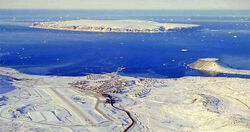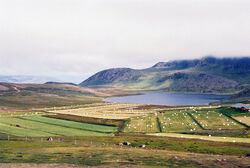
Thule Air Base in the foreground with North Star Bay, which was covered in sea ice at the time of the accident, in the background in 2006.

Southern Greenland lives up to its name as it is truly a green land. Agriculture thrives here with many farms and luxuriant vegetables, in contrast to a barren ice world that covers much of Greenland. Hay is harvested in Vatnahverfi, Garðar. Southern Greenland lives up to its name as it is truly a green land. Agriculture thrives here with many farms and luxuriant vegetables, in contrast to a barren ice world that covers much of Greenland. Hay is harvested in Vatnahverfi, Garðar, in 2006.

A view of Scoresby Sund in eastern Greenland, the longest fjord in the world.

VLJ Embraer Phenom 100 Landing at Narsarsuaq Airport in Greenland (BGBW)
VLJ Embraer Phenom 100 Landing at Narsarsuaq Airport in Greenland (BGBW).
Overview[]
Greenland is a constituent part of the Kingdom of Denmark located in North America. From being a dependency to the Kingdom of Denmark, Greenland became an integrated part of Denmark in 1953, and also became a part of the European Communities in 1973 when Denmark joined. Greenland attained self-rule within the kingdom in 1979 and following a referendum it left the European Communities 1985. Becoming the second territory to leave the future European Union after Algeria gained independence from in the 1960s. In 2009 it attained further autonomy within the kingdom by a new self-government act.
Background[]
Greenland, the world's largest island, is about 81% ice capped. Vikings reached the island in the 10th century from Iceland; Danish colonization began in the 18th century, and Greenland was made an integral part of Denmark in 1953. It joined the European Community (now the EU) with Denmark in 1973 but withdrew in 1985 over a dispute centered on stringent fishing quotas. Greenland was granted self-government in 1979 by the Danish parliament; the law went into effect the following year. Greenland voted in favor of increased self-rule in November 2008 and acquired greater responsibility for internal affairs in June 2009. Denmark, however, continues to exercise control of Greenland's foreign affairs, security, and financial policy in consultation with Greenland's Home Rule Government.
Economy[]
The economy remains critically dependent on exports of shrimp and fish and on a substantial subsidy - about $650 million in 2009 - from the Danish Government, which supplies nearly 60% of government revenues. The public sector, including publicly owned enterprises and the municipalities, plays the dominant role in Greenland's economy. Greenland's GDP contracted about 2% in 2009 as a result of the global economic slowdown. Budget surpluses turned to deficits beginning in 2007 and unemployment has risen. During the last decade the Greenland Home Rule Government (GHRG) pursued conservative fiscal and monetary policies, but public pressure has increased for better schools, health care and retirement systems. The Greenlandic economy has benefited from increasing catches and exports of shrimp, Greenland halibut and, more recently, crabs. Due to Greenland's continued dependence on exports of fish - which account for 82% of exports - the economy remains very sensitive to foreign developments. International consortia are increasingly active in exploring for hydrocarbon resources off Greenland's western coast, and international studies indicate the potential for oil and gas fields in northern and northeastern Greenland. In May 2007 a US aluminum producer concluded a memorandum of understanding with the Greenland Home Rule Government to build an aluminum smelter and a power generation facility, which takes advantage of Greenland's abundant hydropower potential. Within the area of mining, olivine sand continues to be produced and gold production has resumed in south Greenland. Tourism also offers another avenue of economic growth for Greenland, with increasing numbers of cruise lines now operating in Greenland's western and southern waters during the peak summer tourism season.
Monarch[]
- Frederik IX (₩) (June 5, 1953 - January 14, 1972)
- Margrethe II (₩) (January 14, 1972 - )
Nation[]
Danish Polities[]
- United Kingdoms of Denmark and Norway (1523-1814)
- Denmark–Iceland
- Kingdom of Denmark (From 1944)
- Kingdom of Denmark: Denmark (From 1945)
- Kingdom of Denmark: Faroe Islands (From 1948)
Neighbouring Nations[]
Also see[]
- Kangerlussuaq Airport
- Thule Air Base, Greenland
- Narsarsuaq Airport
- HDMS Hvidbjørnen (F360)
- Slædepatruljen Sirius
- Soviet invasion of Greenland
- Grønnedal navy base, Kangilinnguit
- Island Command Greenland, Nuuk
- 1968 Thule Air Base B-52 crash
- The Soviet Submarine K-19 accident
- The Arctic and the Antarctica
- Pollution in Greenland
- Ice, sheet ice, pack ice, ice-caps, glaciers snow and cold
References[]
- #The World Factbook (CIA)
- #Chiefs of State and Cabinet Members of Foreign Governments (CIA)
- #BBC News Country Profile
- #BBC News Time Line
- #World Statesmen.org